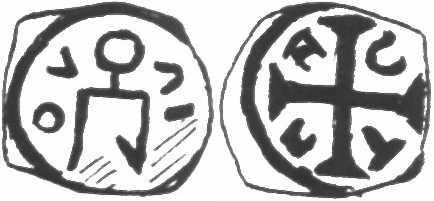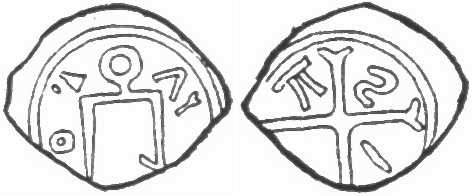
|
Events
News
Members
articles
Publications Book reviews Site search Internet Membership About ONS |

|
|
Konstantin Khromov, khromov@svitonline.com
In my collection there is a rare copper coin (fig.1) found at Stary Qrim in the Crimea. Coins similar to this one have been attributed in the past and published by Iliesku. They have generally been found within the area of the Danube and Dniester estuaries. Iliesku dated them to the period between 1310 and 1375AD and he suggested that they were struck at the town of Vicinia. At the same time? he left that attribution open to discussion. Figure 2 is a drawing of one of these coins made by Giuseppe Lunardi1. The specimen in my collection is in a better state of preservation though even that one does not have the complete design on it. It does, however, enable me to refine the attribution somewhat. There are no Arabic legends on the coin. It is more likely to be a Latin legend rather like those on the Tartar coin types struck at the end of the 13th – beginning of the 14th centuries and containing the name of the town where minted. There is also a possibility that the characters to the left of tamgha are two Arabic numerals - residues of the date (.07, i.e. 707 AH), while those on the right are the remains or first two letters of the mint-town in Latin. In dating this type of coins one has to take into account the practices of using a tamgha as a major component in Golden Horde coins. The tamgha of that sort appears on the coins of the Tatars from around 1270AD and they exist in different varieties until 1325AD, after which date they disappear from the coins. The closest version of the tamgha corresponding to that on the above coins is found on the dirhams of 707AH (1307 AD), copper falus after 706 AH, minted at Qrim by Toqtu Khan (1291-1312 AD) and on copper falus of Ozbeg Khan also minted at Qrim with dates before 725 AH (1325 AD). In terms of style, weight, design and production method, these coins fit in with this period and I would date them to between 1305 and 1325 AD. Thus I would describe the coins as follows: Obverse: in the center - the tamgha of the Batu family; to the left and right, fragments of a Latin legend of 4-6 letters. All within a circle. Reverse: a cross of Lorraine within a circle; between the rays are four Latin letters imitating the year of minting.
 fig.1  fig.2 |
||
 | ||
| ons@onsnumis.org | © 1999-2024 ONS | |